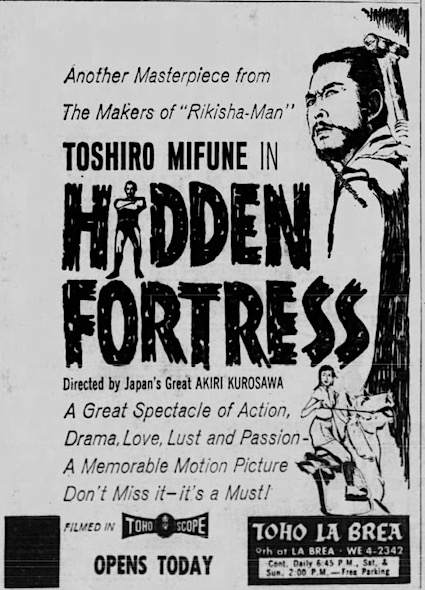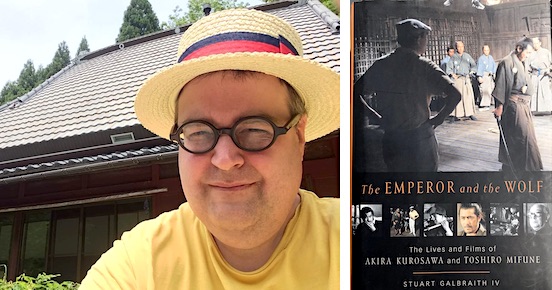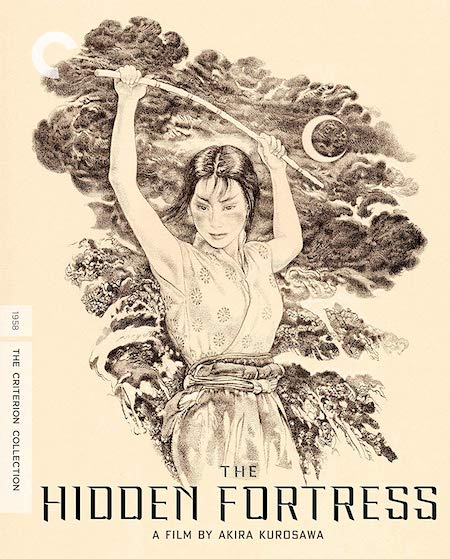Stuart Galbraith IV is the author of The Emperor and the Wolf: The Lives and Films of Akira Kurosawa and Toshiro Mifune (Faber & Faber, 2002).
Galbraith’s other books include Japanese Cinema (Taschen, 2009), The Toho Studios Story: A History and Complete Filmography (Scarecrow, 2008), Monsters are Attacking Tokyo! The Incredible World of Japanese Fantasy Films (Ferel House, 1998), The Japanese Filmography (McFarland, 1996), Motor City Marquees: A Comprehensive, Illustrated Reference to Motion Picture Theaters in the Detroit Area, 1906-1992 (McFarland, 1994), and Japanese Science Fiction, Fantasy, and Horror Films (McFarland, 1994).
Galbraith has worked as an archivist for the USC-Warner Bros. Archives and Warner Bros. Corporate Archives, written essays that have accompanied some home video releases of Seven Samurai, Rashomon and The Quiet Duel. As well, Galbraith recorded audio commentary tracks for Invasion of the Astro-Monster, Tora! Tora! Tora! and The Sadist. He has also reviewed nearly 2,000 titles for DVD Talk and is a member of the Online Film Critics Society.
Galbraith kindly spoke to The Bits about the appeal and legacy of The Hidden Fortress.
Michael Coate (The Digital Bits): How do you think The Hidden Fortress should be remembered on its 60th anniversary?
Stuart Galbraith: I think it probably should be remembered as the picture Kurosawa set out to make and, I think, achieved: what he called “100% entertainment.” It’s no more or less than that — an exceptional piece of fairy tale-like escapism.
 Coate: Can you recall the first time you saw The Hidden Fortress?
Coate: Can you recall the first time you saw The Hidden Fortress?
Galbraith: The Hidden Fortress was actually the last major Kurosawa film I saw. (My first Kurosawa was Yojimbo, seen at a college screening in 16mm back in the 1970s, when I was around 15 or 16.) Somehow I missed The Hidden Fortress when it was re-issued in the U.S. in 1984 — the first time outside Japan at its original length — so I think my first experience was probably Criterion’s LaserDisc version.
Coate: In what way is The Hidden Fortress a significant motion picture?
Galbraith: It was significant on several fronts. It was Kurosawa’s first movie in anamorphic wide screen, Toho Scope, the company’s version of CinemaScope, and the first to be released in stereophonic sound, albeit Perspecta, which had its limitations. Kurosawa took to the new screen shape like a fish to water, though that in itself isn’t especially remarkable, as Japanese filmmakers at all levels adapted to ‘scope better and more quickly than their American counterparts. In any case he certainly used the format to its fullest advantage, and personally I think his compositions and especially the blocking of his actors really blossomed just as he was a little bit restricted by the limitations of 1.37:1 standard format. I suppose his mastery of ‘scope is perhaps best represented by the final scene in High and Low.
I think the movie also demonstrates that, like many of the shrewdest Hollywood directors — Hawks, Ford, Hitchcock and so on — that Kurosawa realized that he needed a real “crowd-pleaser” hit after Record of a Living Being, The Lower Depths, and Throne of Blood. Those movies were acclaimed and won various awards at home and abroad, and Throne of Blood was Toho’s top-grossing movie of the previous year, but after three very dark films he understood that some lighthearted escapism was probably a good thing at this point in his career. And he was correct: it made around 362 million yen (around $1 million) in Japan, making it extraordinarily popular by the standards of the day, and it ranked second on the influential Kinema Jumpo magazine’s list of the year’s best films.
Finally, I think it was with The Hidden Fortress that Kurosawa’s relationship with composer Masaru Sato really began to bear fruit. He’d written the scores for The Lower Depths and Throne of Blood, but in The Hidden Fortress Sato’s music really becomes an essential ingredient.
Coate: In what way was Akira Kurosawa an ideal choice to direct The Hidden Fortress and where do you think the film ranks among his body of work?
Galbraith: Well, to be clear, it was a script he developed from the outset, and it’s hard to imagine anyone other than Kurosawa directing it. Most big-budget Japanese historical pictures of the time tended to be rather stately, all-star affairs, like Hiroshi Inagaki’s big movies for Toho during that period, such as his Musashi Miyamoto trilogy or his 1962 Chushingura. And like Chushingura they tended to be based on iconic stories that good be filmed again and again through myriad interpretations. Those films, good as they are, also tend to be pretty humorless, whereas The Hidden Fortress is quite funny. Conversely, I can’t imagine any director of that time building such a sweeping epic around two comically cowardly, incessantly bickering and scheming peasants. Anyone else would have had a virtuous samurai lead along the lines of the kinds of characters Kinnosuke Nakamura was playing.

Coate: Can you discuss Toshiro Mifune’s performance? In what way was he ideal for the role of General Makabe Rokurota?
Galbraith: One factor is that no one could play such an intimidating character that could so believably make the two peasants, played by Minoru Chiaki and Kamatari Fujiwara, cower in fear with nothing so much as a glowering stare. The story, too, depends largely on a great bluff, a princess and a general pretending to be peasants carting firewood and all that, and the great scene where he rides into the nest of enemy soldiers, besides Mifune getting out of that situation through sheer bravado, begins with that great moment of Mifune on horseback, hell bent for leather. I don’t think many big male stars of that era would have rode so furiously and dangerously, even for a director with the stature of Kurosawa.
Coate: How would you describe The Hidden Fortress to someone who has never seen it?
Galbraith: The obvious one, of course, is Japanese Star Wars. No Death Star, but the plot is more or less the same and the characters are instantly recognizable. It’s also a good place to start if you’ve never seen a Kurosawa film or even a Japanese film. The story is easy to follow, it’s highly entertaining, and from a filmmaking standpoint plays very modern even today. And on a big screen with a decent projection system, it sure looks epic.
Coate: Has The Hidden Fortress been well-served on its numerous home-video releases?
Galbraith: Yes. If I remember correctly, even the VHS release was letterboxed from the beginning. When Criterion announced the DVD, my very tiny contribution was to contact them offering to put them in contact with someone I knew who could help them decode the original Perspecta Stereophonic Sound tracks. I think they ended up doing that through somebody else, but I applaud them for doing that on Hidden Fortress, as well as other Japanese Perspecta titles. My memory is that there’s hardly noticeable directionality to the audio on Hidden Fortress, but on other Toho films the use of this process is often very effective. And the most recent incarnation of the film looks great.
Coate: Where do you think The Hidden Fortress ranks among the jidai-geki genre?
Galbraith: Very high, of course, but again it’s also really a kind of one-off picture unlike the usual jidai-geki.
Coate: What is the legacy of The Hidden Fortress?
Galbraith: It’s basically an irresistible blend of grand comic adventure with Kurosawa’s emblematic humanism and innovative craftsmanship. It’s genuinely rousing, a great film to see with a big, receptive audience, and just enormous fun.
Coate: Thank you, Stuart, for sharing your thoughts about The Hidden Fortress on the occasion of its 60th anniversary.

SPECIAL THANKS
Alain Dorange
IMAGES
Selected images copyright/courtesy Asahi Shimbun, The Criterion Collection, Los Angeles Times, Toho Company.
- Michael Coate
Michael Coate can be reached via e-mail through this link. (You can also follow Michael on social media at these links: Twitter and Facebook)




